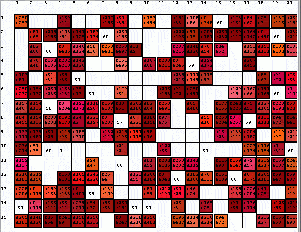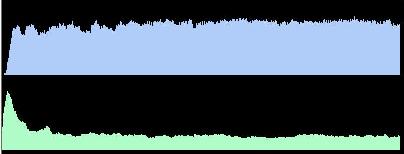Group 1: Project 4
Project 4: Organisms II
Group 1:
Contents:
|
|
|
Please note that in all images following, Group 1's player is the red colored player.
|
Introduction
Our overall approach was to implement and evaluate many different
strategies and take the strongest parts of each. This methodology led us
to several good approaches as well as several bad ones.
In this paper, we first examine the background of the problem, where we
analyze the different phases of games, as well as how the board parameters
interact to create different types of boards. We then discuss the common
foundation on which we built our different strategies. We then examine
the strategies in detail, and move on to talk about how we tuned them to
work well under a variety of circumstances. Finally we discuss the
results we've observed and the conclusions we've drawn from them.
[ top ]
Background
In order to understand how to make a strong player, it is first necessary
to understand how games work. Games can be broken into three phases, and
it is important to understand what behavior is best for each phase. In
addition, the board variables, both known and unknown, must be used to
tailor each player to its particular circumstances.
The phase of the game include the growth phase, the overpopulation
phase, and the steady-state phase:
Phases of the Game
- Growth Phase
The growth phase occurs at the beginning of the game. In the growth
phase, the board is mostly empty; thus, food appears often and grows
quickly. (In general, it can be said that the rate of change of the
number of automata on the board is proportional to amount of available
food on the board minus the number of automata currently in existence.
By comparison, the rate of change of food is inversely proportional to the
density of the players.)
In the growth phase, players seek out their first food. This is a
critical time, because if a team's first automaton cannot find food, the
team will go extinct. Furthermore, the automata have no knowledge of the
values of p and q. If p turns out to be sufficiently high, the automaton
that takes a chance by wandering around will be rewarded by finding food
quickly and being able to proliferate before conservative players, and
generally leading to the extinction of the conservative players. However,
if p turns out to be very low, the player who stays still and conserves
his energy is most likely to survive long enough to find food, while the
aggressive player has gone extinct. Whether an organism's initial gamble
on the value of p pays off determines whether he succeeds later in the
game, and there is no way to avoid this gamble.
(It could be argued that by staying put, a player could wait a few turns
to estimate p. However, in practice, a player who stays put makes 4
observations about p every round. If the value of p is .01, the expected
value of the wait is 12 rounds, and this produces a vast overestimate of
p. If the player wants to make a more reliable estimate of p, he must
wait perhaps 400 rounds. If at that time the player concludes that p is
sufficiently large that movement is appropriate, he has given a 400-turn
advantage to players who assumed a high value of p from the beginning.
Thus by choosing to measure p, he has implicitly assumed that p is small,
and will be unable to compete if p turns out to be large.)
Once the abundance of food is discovered, automata reproduce rapidly to
consume the plentiful food that is available. The end of the growth phase
is marked by a downturn in the amount of food available on the board --
this occurs when organisms have reached most parts of the board and are
consuming the food that is available faster than it is reappearing.
[ top ]
- Overpopulation Phase
The overpopulation phase begins when the first downturn in available food
occurs. In this phase, there are necessarily more automata on the board
than the food growth can support, because overcrowding prevents adequate
food growth. After the food that grew in the growth phase is exhausted,
the automata death rate far exceeds the birth rate.
In this phase, some automata need to die, and the weakest die first.
Survival in this time does not require automata to have a lot of energy,
but only to have more than those weakest automata; once the weak ones die,
the remaining automata all have an equal chance of finding the food.
Wandering, the practice of moving around through empty squares in search
of food, is expensive in this phase. Food is generally not available, and
the high board density means that any new food that appears will probably
be consumed by a nearby automaton, so wandering is not likely to produce
more food than staying put. Furthermore, wandering has a certain energy
cost associated with it, and too much wandering may cause automata to have
the least energy and thus be the first to die.
The overpopulation phase ends around u*K turns after it begins. This is
about enough time that an automaton who found a pile of the maximum food
to consume it all, and any automata who found less food has either been
able to find new sources of food or has died out. Note that for the
values used in the tournament, the overpopulation period may last anywhere
from around 1,000 turns to around 10,000 turn.
[ top ]
- Steady-State Phase
The final phase occurs when automata have died off in sufficient numbers
that a roughly stable number of automata are left. From this point on,
there are cycles of growth and overpopulation, as food recovers and is
then found and eaten. However, these swings tend to be far smaller than
the initial one, and are often localized to particular areas of the board.
It still holds true that with each swing, the weakest automata die off,
and the stronger ones are left to replace them.
The cyclic nature of the size of the overall automata population does not
necessarily hold for automata of any individual team. If, for example,
one team's automata tend to have low energy at the population peak of
cycles, these automata will tend to die off.
Interestingly, even if one team's automata are not consistently at the
bottom of the energy ladder, extinctions will still occur. This is
analogous to the gamblers' ruin problem. The situation of gamblers'
ruin is one wherein a gambler plays a perfectly fair game in a casino
until either he or the casino runs out of money (in our case, the casino's
bank is the other players' automata viewed together, and the player's
automata comprise the gambler's money). As the gambler plays, he wins
sometimes and loses sometimes, just as the players' population increases
and decreases. The gamblers' ruin occurs when he runs out of money, at
which time he is forced to stop playing, even though we know that if he
had infinite money, he would with probability 1 recover his losses. The
problem for the gambler is that the casino has much more money than he
does, so with very high probability, he will run out of money before the
casino does. Likewise, a player with a low number of automata will with
high probability go extinct before the other automata, even if the
expected value of his growth rate is 0. Furthermore, a gambler playing a
game of higher variance of cost/payoff (or volatility) -- or a player
who experiences greater swings in population -- is more likely to run out
of money/automata sooner.
In the steady-state phase, wandering may be good or bad, depending on
board parameters.

In this graph of food available on the board vs. time, the growth
phase is the time when food is initially rising, the overpopulation
phase is when the food falls back down almost to zero, and the
steady-state phase is when the food stays fairly constant.
[ top ]
Analysis of Board Parameters
The board parameters govern which strategies will succeed and which
will fail.
- Board Size (x and y)
A large board size is important in three ways. First, it provides
a greater chance for all teams to develop independently for a time,
without competition. Second, a large board ensures a large growth
phase -- if the board is densely populated quickly, the growth phase
will barely have begun when overpopulation occurs. Finally, with a
medium-to-high value for q, large piles of food will exist, which adds
an incentive for players to find and utilize this food in an
intelligent way.
[ top ]
- Food Growth (p and q)
For high values of p, food tends to be evenly distributed around
the board. This benefits aggressive players who move and reproduce
from the beginning of the game, rather than waiting.
For low values of p, reproduction and wandering are penalized.
Luck at the start of the game generally makes the difference between
success and failure. These conditions benefit conservative players
who wait at the beginning of the game to observe p.
For low values of q, piles of >1 food generally don't exist. It
does not matter whether the food doubling chance is one in 10,000 or
one in a billion; as q decreases, below .0001, it becomes
insignificant.
If the ratio q/p is high, this leads to high variance in food
distribution around the board: over time, large piles of food exist in
a wasteland of no food. On the other hand, if q/p is low, q is
insignificant.
[ top ]
- Food Yield (u)
If food yields a lot of energy, the board can support very dense
populations, since an automaton that eats just one food can survive u
more turns without food. By contrast, a low value for u means lower
populations and likely a lower average lifetime for automata, as
unlucky ones will not find enough food to survive.
[ top ]
- Ratio of Food Yield to Movement Cost (u/v)
A higher u/v means that wandering is more profitable, because the
payoff from eating makes up for many turns of wandering in search of
food. If u/v is low, wandering in search of food is more expensive.
[ top ]
- Maximum Food Per Cell (K)
Higher values of K mean that high-food-variance boards will have
even higher variance; protecting good sources of food on such boards
is more profitable than on low-K boards.
[ top ]
Foundation
- Assumptions
Given that we need to make a gamble about initial p and q, we
assume that p will be sufficiently high that wandering is useful. In
this assumption, we essentially concede all games where p<.0001, and
concede a lot of games in the range in the range .0001 < p < .001.
This includes single-player games as well as multi-player ones; in
single-player, the optimal strategy is always to wait and observe for
a while, since there is no competition. We do not do this because we
want to be optimal for multi-player games.
[ top ]
- Estimating p, q, and Board Crowdedness
In order to better make decisions about what to do, all our automata
maintain a history of certain observations.
- Estimating p
Every time an automaton stands still (including when it reproduces), it
compares the list of adjacent squares empty of food and automata before it
stayed put to the list after. If it sees that food appeared on a square
that was empty on the previous turn, it records this observation; if it
sees that food did not appear on such a square, it also records this.
Thus every automata can estimate p as the ratio of the number of food
appearances to the total number of tests. The variance of this estimate
is very high when the number of observations is less than 1,000, and is
still high when observations number in the thousands, because this number
of observations is insufficient to provide a good estimate. However, for
an estimate of the order of magnitude of p, these observations are
sufficient.
- Estimating q:
Each time an automaton revisits a food square that it has already
visited, it can make an estimate of q. Since food growth is
exponential, the following formula can yield an estimate for q:
(foodAfter+turnsOccupied) = foodBefore * (1 + q)^(turnsSinceSeen)
where foodAfter is the amount of food in the second observation,
foodBefore is the amount of food in the first observation, turnsOccupied
is the number of turns the square is known to have been occupied, and
turnsSinceSeen is the number of turns between observations. This formula
is slightly incorrect in that it matters not just that the cell was
occupied but at what time it was occupied. We ignore this error for
simplicity.
However, even with this formula, estimates tend to be orders of magnitude
off. The biggest problem is that data about q is hard to collect: it
requires moving onto, off of, and back onto food, and risking that in the
intervening time another automaton will move onto that food and not move
off. Thus it is only truly feasible to measure q if an automaton is a
farmer. But even as a farmer, one generally visits the pile of food
rarely, and the food is visited many times in between by other farmers, so
the data are likely to be skewed severely.
We did not end up using estimates for q in any of our strategies.
- Estimating Board Crowdedness
Board crowdedness is a measure of how densely populated the board
is with automata. We attempt to measure this by looking at how many
other automata a given automaton has seen in the past 1, 3, or 5 turns
(sometimes weighting more recent observations more heavily). However,
these measurments were often very similar for crowded boards as for
uncrowded boards, so we did not use them in any of our final
strategies.
[ top ]
- Communication
We created a complex communication scheme for passing information
between automata. In the end, we found that simple encrypted
communications were too insecure to be reliable, and too costly to
make secure. However, we laid the groundwork that others might use
for strategies that require more complex message passing.
- Parent-To-Child Messages:
Communications from a parent to the child on the turn of birth are special
in that there are 4 bytes available, and that the communication is
guaranteed to be secure. All of our strategies require that two of the
four bytes be used for the turn-key, which is used for encryption (and
discussed later). The other two bytes are left to the disgression of the
strategy. Some strategies pass a location of food or of other importance,
while others pass genetic information to allow for adaptation to varying
environments.
- Inter-Automata Messages:
Message passing between automata suffers from a variety of
problems. The most basic is that automata cannot easily authenticate
one another as members of the same race to share information.
Furthermore, all information is broadcast to all adjacent players, so
even if one knows that the target of the communication is of the same
team, other enemy automata are able to hear the message. A third
problem is that messages do not contain direction information so
automata do not know if they are being addressed; a fourth is that the
bandwidth of communcation is very low: only one byte can be passed to
all neighbors every turn. A fifth problem is that time is quantized
in large segments, hindering encryption: any message that one
automaton broadcasts in one time slice may be intercepted and
rebroadcast in the same time slice, and it is impossible to use a time
slice finer than a turn. A sixth is that a discontinuity exists at
board edges, leading to difficulty differentiating an attacker whose
attack is a turn behind from a friendly player who is across a board
boundary.
These challenges are far from small, and arguably make
communication an impossible endeavor. However, to address most of
these problems, we propose the following scheme, which we call
Secure Communication Over Very Low Bandwidth Channels In Quantized
Time:
- Every communicating party must have a shared secret key. This can be
shared through automata parent-child message passing. The first
automaton picks this key at random.
- Each turn, the shared secret key is hashed according to an algorithm
common to all automata, so that it is generally different each turn.
- Every automaton of our team broadcasts the same message, found by
hashing the secret key and a constant, to identify itself as a likely
member of our team. However, broadcasting the shared message is never
used as proof that the automaton is on our team.
- When two automata of our team want to communicate with each other, each
broadcasts a random challenge.
- Each automaton hashes the others' challenge using the turn-key, unless
the random challenge was the same as the challenge issued by the
automaton. If the challenges are the same, a new challenge is
selected and broadcast -- otherwise the challenger could be a member of
another team masquerading as one of us and trying to learn the answer
to our challenge. If two reptitions turn up the same challenge, we
give up and assume the other is simply replaying our message and not
actually of our team.
- If the challenges were successfully hashed, each automaton accepts that
the other has authenticated. An automaton is not allowed to move if he
is engaging in communication, and must not communicate if he is about
to die; this prevents another automaton from hijacking an
already-established secure communication channel.
- Information is now passed between the automata, one byte at a time.
For security, the message is encrypted by xor'ing it with a hash of the
turn-key plus a constant, so that neighboring automata cannot
understand what is being communicated.
- When an automaton wishes to move, it must send an end of channel
message to terminate the connection so that the other automaton will
unauthenticate an automaton in the square that is about to be moved
out of.
We implemented the bulk of this system, but communication was
sometimes hampered by off-by-one errors that we did not spend the
effort to fix. Though this algorithm suffers cryptographic weaknesses
in that the length of the key is small and that frequency analysis on
messages may lead to the key being revealed, it is probably more than
sufficient encryption for the scope of this project if the bugs are
worked out. There is a certain cost of communication -- automata
cannot move while they are communicating -- so it can probably be
afforded only on boards where movement is expensive.
These costs of encryption mean that most groups do not use multi-turn
encryption. The alternatives to multi-turn encryption include:
- using half the byte broadcast for authentication and the other half for
the message
- having all members of the team broadcast the same message on a given
turn, but not passing a separate message
- assuming that everyone else is of the same team to begin with
This leaves them open to certain attacks. We implemented the following
replay attack, which is employed by all of our automata on all turns
except where they need to communicate with one another:
Whenever you hear a byte, you repeat it. We prefer to repeat a
byte from an earlier part of the board (north then west) over a
later part of the board (east then south). Furthermore, we
repeat the message verbatim only 50% of the time -- the other 50% of
the time, we flip one bit, selected at random, before rebroadcast.
For alternative communication method 1, 50% of the time we rebroadcast the
message that the enemy automaton sent us, which is hopefully interpreted
in a hurtful way; for example, if that automaton was sending us a location
of food relative to it, we will send back an incorrect location of food
relative to us. Alternately, 25% of the time we rebroadcast a corrupted
message that the enemy will interpret as authentic. For method 2, 50% of
the time we successfully impersonate a member of that team. For method 3,
we likely pass back a valid but incorrect message.
We are unsure of how successful replay attacks were at confusing
other players; however, we have observed at least one instance of an
opposing player walking off a big pile of food when we replayed to
that automaton the message that it previously sent to us. Thus we
suspect that in a small number of cases, our communications spoofing
worked to our advantage.
[ top ]
- Mapping
All of our automata maintain a map of every cell they know about.
This map includes information about how much food is believed to be on
that cell (which would use our estimate for q if it were accurate),
how long ago this cell was visited and observed (with observed
indicating we were next to the cell but not on it), and what automata
we have seen on that cell.
This mapping functionality includes navigation functions for moving
to a certain cell, and a neat printable map for debugging.
[ top ]
Spiral
The spiral strategy is simply to walk in a spiral looking for food. We
chose the spiral because, unlike walking in a line, it guarantees that
some new squares will be covered in each iteration (at least until the
entire board is seen). Furthermore, for large boards, most of the squares
seen will be squares that have not yet been seen.
This strategy alone does not involve a rule for when to reproduce, so in
any circumstance where reproduction is sometimes desirable (essentially
where v>1 and p>.00001), this strategy fails.
[ top ]
Always Reproduce
The always reproduce strategy is, very simply, for every automaton to
always reproduce on every turn if it is able. This strategy has the clear
drawback that it consumes a lot of energy, and is therefore only viable on
boards where u and p are high. However, the fact that this strategy is
viable under certain circumstances is interesting.
[ top ]
Lazy Player
The lazy strategies take the attitude that movement is expensive but
standing still is cheap. The essence of all of them is that for
sufficiently high p, they are better off waiting for food to appear next
to them than they are spending energy looking for food.
The lazy strategies are divided into two subtypes: Simple Lazy and Scatter Lazy.
3A. Simple Lazy (Couch Potato)
Our couch potato strategy follows the following simple set of rules:
- If you're not on food and there's food available next to you, move onto
that food.
- If you're on food and there's food available next to you, reproduce
onto that food.
- Otherwise, stay put.
Assuming no competition and initial survival long enough to find
substantial food (the latter assumption being perhaps unreasonable), the
couch potato player can survive under almost arbitrarily low values of p.
The place where this strategy fails is when the food distribution variance
is high. For example, if p is low, q is high, and v is not too large,
then wandering is necessary if one is not lucky enough to have food appear
in an adjacent square.
|
|
[ top ]
3B. Scatter Lazy ("Coconuts")
Our scatter strategy is the same as the couch potato strategy, except that
we impose a rule that after birth, an automaton must move at least n
squares away from its parent before moving into the lazy strategy. We
take this idea from certain coconut trees, whose coconuts will only grow
into new trees if first they are soaked in salt water -- the goal being to
spread out the new trees so that they do not interfere with their parent.
Similar to the coconut tree, we found that the lazy strategy suffers from
the problem whereby the children are all clustered near the parent. In
the opening phase of the game, when food is much more abundant in
locations farther from where automata started life, it's important to
cover as much territory as possible. Thus we imposed this rule.
In a head-to-head matchup of Couch Potato and Coconuts (with scatter
distance n = 4), neither one is clearly better than the other. In 10
trial runs, Couch Potato won 6 times and Coconuts 4. It appears that luck
in finding food in the initial stages has a much more significant impact
on the game than whether or not scattering is used.
[ top ]
Checkerboard
The checkerboard approach involves arranging automata in diagonal rows --
like a checkerboard -- in order to create and defend pockets of food in
the spaces between the automata (the "white squares" of the checkerboard).
We call the spaces occupied by automata the "even squares" and those
reserved for food the "odd squares". The theory is that automata can then
move into the odd squares when they are hungry, and otherwise remain on
the even squares so that food will develop on the odd.
Our implementation of this approach suffered from some problems. The
guiding rule of the implementation is that each automaton is always born
on an even square, and he uses that as his frame of reference. When he
moves onto an odd square, if he has sufficient energy, he reproduces on to
each adjacent even square, in order to expand the checkerboard.
The problem occurs when two automata have both left their even squares and
moved onto odd squares that border one anothers' even squares. They each
think that there is a hole in the checkerboard in the place where the
other was, and each reproduces to fill the even square "owned" by the
other. Thus the even and odd squares now have automata on them, and no
food can grow. Unfortunately, this happens too often to make our
checkerboard implementation competitive in a multiplayer environment.
This problem might be solved by better communication and better rules
about when to reproduce.
[ top ]
Dumb Army
The purpose of the dumb army strategy was the spread the organisms out in a horizontal line, and then begin to
march in procession up the board. If an organism was unable to reproduce to the east or west, but could reproduce to the
north, the organism would reproduce to the north. This emphasis on reproduction led to an early swarm that dominated the board. There was a semi-conservative strategy built-in to temper the agressive reproduction, in that the organism would check to see if
it had twice V, and that the area they were reproducing into containted food. In a case where the player could not reproduce,
it would move north. In all other cases, it would stay put. In its implementation, this strategy had less to do with marching than the
aforementioned ability to swarm the board at an early stage. The organism even seemed to dominate other organisms in early trial runs, however it was revealed that ultimately, the organism would die out almost as quickly as it built itself up, having focused on reproducing and not spending any time searching for food. So while this strategy may have been good in a destructive sense, to weed out other competitors, it had no staying power and was therefore abandoned.
[ top ]
Farm
farm
n.
1. A tract of land cultivated for the purpose of agricultural production.
Farming is the use of organisms to block off a section of the board
from other players, in order to allow the food in that area to grow
unimpeded by the risk of organisms eating or resting on the area and
preventing the food from staying at a high enough level. In general,
this is done by having at least four organisms occupying the tiles
around the food, forming a shape that blocks off the squares of the
food. The walls have their energy replenished either by stepping in
to the farm to regain their energy, or by having a queen inside the
farm reproduce outwards in order to regenerate weakened areas of the
farm.
The goal of farming is to maintain levels of food on the board in
the steady-state phase that are similar to those at the end of the
growth phase, to allow our team to maintain high automata populations.
Diamond Farm
The diamond farm is a farm where automata initially arrange
themselves in a diamond pattern, and then try to expand the diamond,
as energy permits, to enclose more and more area inside the farm.
An automaton following the diamond farm strategy follows these
simple rules:
- If the farm is not yet formed, generate more automata to form a
minimal farm, filling the final part of the farm wall my moving rather
than reproducing.
- If an automaton on the wall of the farm needs food, it goes back
to the farm center to get food.
- If an automaton on the wall of the has more energy than it needs,
it reproduces at right angles to its path to the farm center.
- If both an automaton's shoulders are guarded by farmers, it
walks outward, away from the farm center.
Under desirable board conditions, these rules generate fairly large
farms. Furthermore, the farms are robust about expanding around
obstacles and still preventing compromise of the farm -- automata will
never expand if it would form a gap in the farm wall.
There are several problems with this general strategy that prevent
us from using it in multiplayer games. For one, when an automaton on
the wall must move back into the farm to feed itself, it may open a
gap in the wall. With a large number of farmers, there is often
contention in the farm's early stages for the square with the food
supply on it, and gridlock ensues in the farm center. More simply,
often the initial food supply is insufficient to sustain a large
number of farmers. These problems are solvable, but require extensive
communication and board analysis, so we gave up on the idea of large
diamond farms.

| 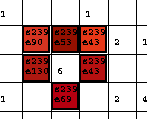
| 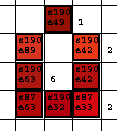
| 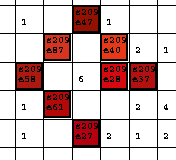
|
|
A diamond farm immediately after it has been established.Some of the wall cells have sufficient energy, so
they reproduce at right angles to the path to the farm center.
| The topmost automaton sees that his shoulders are
guarded and steps away from the center, expanding the farm.
| The diamond farm has reached size 2, but now the
lower-right automaton is hungry and is heading back for food, thus
leaving a hole in the farm wall.
|
[ top ]
Queen Farm
|
Another method of farming which we implemented, but did not submit for the tournament, is Group1Farmer, which forms a farm with a queen in the center that
regenerates the walls of the farms. The farm is formed when an organism finds
a large pile of food in an area of the board that is relatively uninhabited.
It replicates six times in order to form the walls of a 2X1 farm.
|
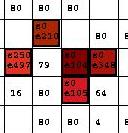
The queen replicates,
forming the walls of the farm.
|

The farm has been formed.
|
|
|
The queen then checks that the farm is complete and notes the energy levels
of all the walls (constantly updated by having the walls communicate the levels
to the queen, since simply measuring the levels at the time of birth might
fail if the wall happened to end up forming its section of the wall on a
tile that happened to already have food.)
The queen then goes through a loop of three stages. It waits in the farm
tile not containing food for a while in order to allow the food to grow. It
then feeds itself for a while, although being careful not to deminish the
food supply too much that it jepordizes the food supply of the farm. It
then chooses a piece of the wall and moves towards it ordering it to step
away from the farm in any direction that was free - where it will stay until
it dies. If the wall cannot move
in any of those directions, it stays where it is. The queen waits several
turns to see if the wall will move, and if it does, it replaces that wall
by reproducing into that tile, forming a new organism with more energy
than it previously had. This regular pushing out the wall helps prevents the
likelihood of two sections of the wall collapsing at the same time, which
would cause problems for the queen that was trying to fill in the gaps.
However, frequently, parts of the walls will die, and so the queen detects,
using the information it maintains and updates of the relative energy levels
of the walls, to detect when a section of the wall is close to dying. When
the queen does so, it drops what it's doing, grabs some food to eat, and
rushes to the tile next to the dying wall. After the wall collapses,
it reproduces into the tile, filling the gap.
|
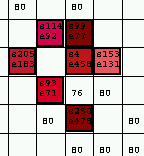
The queen asks a piece of
the wall to move away.
|
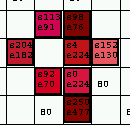
The queen reproduces into
the empty slot left by
the recently departed organism.
|
|
|
This farm is hard to establish -making it good as a supplemental strategy enacted
whenever an organism goes onto a tile where the conditions are right, but
not as a primary strategy. In order set up, an organism has to be on either a large
food supply - or there has to be a very high q value - capable of maintaining all the walls in the farm.
It also requires an empty area of 3x4 in order to establish. This
prevents it from being useful in many cases, especially crowded boards or one
in which food does not grow high or fast enough. But in the cases where
it does form, the farm is self sufficent and does not require food outside
the farm. This makes the farm survive under harsh p conditions, since it
does not require new food to pop up, only growth of it's own farm, and it
makes the player's population stabilize.
This farm is very secure - because there are very few instances when the
wall is not complete, and never for more than a single turn, since the
queen has prepared to reprduce into that wall. Indeed, the walls to the
west and north are secure enough that there is no way to infiltrate it.
The walls to the east and south are more vulnerable, and another organism can
infiltrate it if it happens to step or reproduce into the tile just as the wall
tile died or moved out of the way - this tends to happen - albeit very slowly -
when the farm is bordering another organism that is going through a very sharp
population growth (often caused by the excess of food around the farm that is
not utilized by the farm since it's not looking outwards). Also, given that parts
of the wall move away from the farm, occupying spaces next to the wall, until these
organisms die, they give an added layer of protection to the farm by prevening
any opponent organism from filling up the spots from which they could infiltrate
the farm.
The farm tself is moderately complex - while communication isn't a big worry,
given that the farm itself is secure from spoofing, coordinating the
regenerating of the wall while making sure to
maintain the food supply may be too much work given that this strategy is only
useful in a few harsh conditions, as opposed to other strategies that have
more general success with less involved organisms.
One modification to this farm is to create multiple farms by having organisms that have left the wall try to create new farms. So I made a modification that had the north most and west most former walls search off and try to create their own
farms. This allowed more farms to grow (although not always in a uniform pattern) and
gave the overall player less vulnerable since all his eggs weren't in one basket, with
an opponent now having to try to destroy multiple farms. Here is a screenshot
of such a player in a single player game where it has created several farms
(as well as a number of other organisms trying to form farms but cannot find
the free space and large food supplies to establish them.)
|
|
|
|
As you can see from the graphs, the population and food supply have stablized somewhat.
Another modification which we worked on, albeit only in theory, was a growing queen ant farm. In this case, wall organisms wouldn't be pushed outwards - merely replaced when they died out. The eight organisms forming the four corners would reproduce into
their corners if they had enough energy. Whenever any two corners on one side got filled, that side of the wall would communicate with each other and so long as there was no one in their way they would move forward, increasing either the length or width of the farm by one. This idea had several flaws - mostly complexity, as well as the likelihood that the farm would expand beyond its means. If the farm was too big, an organism may use up too much food to reach the food or the point of the wall to be filled. The queen would also have to deal with several parts of the wall dying within a small period of time. The idea of having multiple queens came up, but the complexity was too high. Also, expanding walls around other organisms was also a complex problem to tackle. In the end, we decided that this idea was too far out of scope.
|
[ top ]
Smart ("Hunters and Farmers")
|
Our final strategy, "Hunters and Farmers," incorporates the spiral, lazy,
and farm strategies into one player, and adds two new components: extra
reproduction and genetic propensity to wander. Automata divide their time
between hunting (using the spiral and lazy strategies) and farming (using
the diamond farm strategy). The important part of this strategy is
deciding when to use each other strategy.
|
|
The smart strategy first evaluates whether the current cell is suitable
for farming, and if so, it starts a farm there. If farming is possible,
we form a diamond farm as above, but we restrict the size of the farm to
1x1. We experimentally determined that 20 units of food is about the
minimum worth farming -- lower and chances are there won't be enough food
in the early stage of the farm to support the 4 automata required to
defend the farm.
|

The basic formation
of the farm in
the Smart Strategy. |
If farming is not appropriate, we consider reproducing if we have "too
much energy." We are fairly conservative, and define "too much" as "so
much that we cannot eat another unit of food." This estimate is
conservative or good for values of p > .0005, but we suffer at the
beginning of the game when food is particularly scarce and we reproduce
when we should be storing our energy.
Next, if we are sitting on food, we follow the simple lazy strategy as
defined above.
If none of the preceding rules indicated what we should do, we decide
whether to wander or stay put. To make this decision, we first look at
the known board parameters -- u, v, and K -- to determine an initial
wander propensity. The formula we use is:
[(v - s)]^(1/2)
Pw = 1 - [-------]
[ u ]
|
In other words, the desire to wander is inversely proportional to the
square root of the ratio of the energy cost of moving (v - s) to the
energy benefit of food (u). We take the square root to scale the
proportion so that a medium value of the ratio (like .5) produces a
particularly low propensity to wander, since the unsquared ratio does not
represent an accurate measurement at these levels.
To this we add our inherent wander propensity, which is fixed for each
organism, but genetically determined so that evolution of wander
propensity is possible. Our initial automaton begins with wander
propensity at +.3, and children are allowed any value between +.4 and
-1.0, with each child varying from its parent by one of {+.2, +.1, 0, -.1,
-.2}.
It turns out that wandering earlier in the game is good, because food is
abundant and tends to exist in greater quantities farther away from
initial positions. However, wandering on more mature boards is bad,
because it is expensive and less likely to yield much payoff, since there
are likely other automata wherever your automata would have wandered.
(This rule holds especially true for high values of u where mature boards
support a large density of automata.) Thus the behavior we observe is
that automata should become less likely to wander later in the game.
This behavior is difficult to install into the automaton brain because it
is hard for any one automaton to discern what the overall board density
is. Therefore we use genetic mutation to solve this problem.
We tried to implement some way for automata to sense the maturity of the
board by looking at how many automata they have seen in the past 1, 3, or
5 turns (weighting more recent observations more heavily). Unfortunately,
there was not a consistently significant difference between measurements in
early stages of the game and measurements at mature stages of the game, so
we do not use this measurement in our decisions.
The strength of the smart strategy is in its adaptability to a variety of
circumstances. For boards where wandering is expensive, it usually sees
that and conserves its energy. For boards where food is evenly
distributed around the board (high p and low q/p ratio), it expands
quickly to fill the board and occupy food before other players get to it.
Best of all is the smart player's performance on boards with an uneven
distribution of food (high q/p ratio), because the farms we create enable
us to sustain significantly higher populations than simple hunting. In
these boards, our farming population protects a large store of food and
provides a base number of automata that generally does not decrease. The
extra energy gained from the farms is used to field an army of hunters
that is much greater than the hunters that could be sustained without the
farms. These excess hunters compete with other players' hunters for what
little food is available on the board outside the farms. The
overpopulation of hunters leads to a famine that afflicts all hunters, so
all hunters -- of all teams -- are continually dying off. However, our
supply of new hunters stays constant thanks to the farms, while other
players' hunters cannot compete and necessarily go extinct.
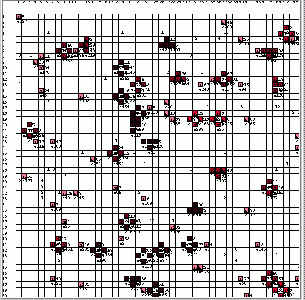
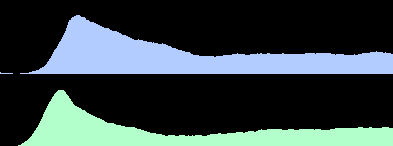
|
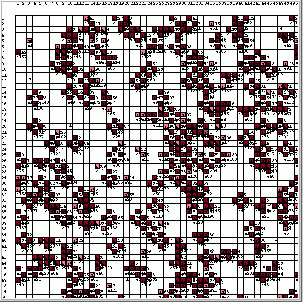

|
Hunters and Farmers player vs. all final submitted players at moment of victory,
{x,y,p,q,v,u,K}={50,50,.0003,.02,4,20,53}
| Hunters and Farmers player alone. Note that the
overpopulation phase does not exhibit the usual sharp decline in the
amount of available food, because there are enough farms to maintain
high levels of food
{x,y,p,q,v,u,K}={50,50,.0008,.02,4,20,100}
|
blue graph = number of automata, green
graph = amount of available food
Note that the amount of available food is maintained at abnormally
high levels thanks to the farms, with the example on the right being
more significant because of the greater abundance of food.
Note also the sinusoidal shape on the falling edge of the green
graph at the right as the amount of available food reaches steady
state.
|
[ top ]
Tuning
To tune our player, we ran many tests, and searched for
correlations between observed board variables and desirable behavior.
Hardcoded tuning is most desirable, because if the player does the
right thing from the beginning, it is much stronger than if it needs
to adapt to the board first while other players are gaining strength.
However, we added genetic tuning of our wandering variable. This
is the one variable we felt is most important and hardest to tune in
advance, since the ideal wandering behavior varies based on the
different stages of the game.
[ top ]
Tournament Results
In single player games, our organism consistently survives so long
as P is greater than .00023. Below this point, we only survive so
long as we happen to be lucky in the start game and happen to find
food quickly.
In multiplayer games, we've found that our survivability tends to
depend on U and V. In games where V is 4 and U is 20 (or where V is
10 and U is 20), we consistently survive when P is between .01 and
.001, almost always being the sole survivors (or at least the team
with the most energy). Below these levels, from around .001 to .0002,
we are generally competitive, especially when we manage to reach food
in time to survive past the initial phase of the game.
For multiplayer games where V is 18 and U is 20, we frequently walk
ourselves to death trying to find food, although when P is high (eg,
.008), we become more competitive, generally becoming extinct towards
the very end of the game. For very low values of P, we tend to die out
before we have a chance to start our farms.
For games in which V is 10 and U is 100, we sometimes survive - although not as well, since everyone performs better under these conditions. We tend to be more competitive when P is lower (but survivable), which
allows our organism to set up and maintain farms, giving our organism
an edge.
For games in which there is little food blowing in, we tend to die off
because we sometimes wander around.
Farming tends to play a role when P is signigicantly lower then Q,
such as when P is .005 and Q is .02, or when walking is very
expensive. As P drops, farms are created more often and so long as q
is high enough for them to survive, they play a more and more
important role.
Our player does particularly well against other players in cases where p is 0.01, and u is greater than v. In particular, as the results below indicate, we dominate the multiplayer situations where u is double that of v. In these cases, where u and v are relatively close, the board will tend to be less dense, and therefore, wandering does well to find food and is conducive to the long term survival of our organism. However, we are not optimized for a more extreme situation, where u is 5 times that of v, and only come in first about half of the time in that situation. We don't do as well in this situation because we assume that wandering is better than it actually is under a situation where u is significantly greater than v. So since, in this case, the board will tend to be more densely populated, wandering is not a particularly appropriate action, since there is a higher probability that any available food we may find while wandering will already be taken by another organism.
|
[X=55, Y=93, u=20, v=10, M=500, K=83]
|
| p | q | Rank |
| 0.010000000 | 0.0200000000 | 2 |
| 0.010000000 | 0.0020000000 | 1 |
| 0.010000000 | 0.0002000000 | 1 |
| 0.010000000 | 0.0000200000 | 1 |
| 0.010000000 | 0.0000020000 | 1 |
| 0.010000000 | 0.0000002000 | 1 |
| 0.010000000 | 0.0000000200 | 1 |
| 0.010000000 | 0.0000000020 | 1 |
| 0.010000000 | 0.0000000002 | 1 |
| 0.010000000 | 0.0000000000 | 1 |
| 0.010000000 | 0.0000000000 | 1 |
| 0.010000000 | 0.0000000000 | 1 |
| 0.010000000 | 0.0000000000 | 1 |
| 0.010000000 | 0.0000000000 | 1 |
| 0.010000000 | 0.0000000000 | 2 |
Multiplayer Tournament
{u=20, v=10, K=57}
|
| p | q | Rank |
| 0.010000000 | 0.0200000000 | died (as did 3
other players) |
| 0.010000000 | 0.0020000000 | 1 |
| 0.010000000 | 0.0002000000 | 3 |
| 0.010000000 | 0.0000200000 | 1 |
| 0.010000000 | 0.0000020000 | 1 |
| 0.010000000 | 0.0000002000 | 1 |
| 0.010000000 | 0.0000000200 | 1 |
| 0.010000000 | 0.0000000020 | 1 |
| 0.010000000 | 0.0000000002 | 1 |
| 0.010000000 | 0.0000000000 | 1 |
| 0.010000000 | 0.0000000000 | 1 |
| 0.010000000 | 0.0000000000 | 1 |
| 0.010000000 | 0.0000000000 | 1 |
| 0.010000000 | 0.0000000000 | 2 |
| 0.010000000 | 0.0000000000 | 1 |
Some results from one of the tournaments
|
Multiplayer Tournament
{u=20, v=4, K=57}
|
p | q | Rank |
| 0.010000000 | 0.020000000 | 1 |
| 0.010000000 | 0.002000000 | 2 |
| 0.010000000 | 0.000200000 | 1 |
| 0.010000000 | 0.000020000 | 1 |
| 0.010000000 | 0.000002000 | 2 |
| 0.010000000 | 0.000000200 | 1 |
| 0.010000000 | 0.000000020 | 2 |
| 0.010000000 | 0.000000002 | 2 |
| 0.010000000 | 0.0000000002 | 2 |
| 0.010000000 | 0.000000000 | 3 |
| 0.010000000 | 0.000000000 | 2 |
| 0.010000000 | 0.000000000 | 2 |
| 0.010000000 | 0.000000000 | 1 |
| 0.010000000 | 0.000000000 | 1 |
| 0.010000000 | 0.000000000 | 1 |
Note that in the situation where {p=.01,q=0.0} we came in first 3 times out of the six runs.
[ top ]
Conclusions
Overall, we feel our player performed quite well in all of the
tournaments where frequent movement was feasible. Our automata bring
to bear a variety of rules and strategies that make it outperform most
other organisms when food is scarce.
Better tuning for a wider variety of board circumstances would have
made it more competitive in the situations where it did less well. By
improving communications and working out some of the problems with
larger farming and analyzing the board to determine how much to
wander, our player could be developed into an extremely strong player.
[ top ]
Acknowledgements
- Group 3's player. We ran their player with debugging output on,
from which we learned the importance of genetically varying propensity
to move. We subsequently implemented our genetic propensity to move
in a very similar way.
- Information on the Gambler's Ruin problem from
http://mathworld.wolfram.com/GamblersRuin.html
[ top ]









